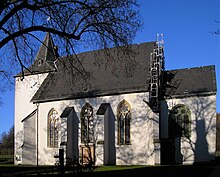St. Lambertus (Stromberg)
|
St. Lambertus in Oelde-Stromberg |
|
| Basic data | |
| Denomination | Roman Catholic |
| place | Oelde - Stromberg , Germany |
| diocese | Diocese of Münster |
| Patronage | St. Lambertus |
| Building description | |
| Construction type | Hall church |
| Function and title | |
| 51 ° 48 '5.9 " N , 8 ° 12' 51" E | |
The Catholic parish church of St. Lambertus is a listed church building in Stromberg (Oelde) , a district of Oelde in the Warendorf district ( North Rhine-Westphalia ).
History and architecture
The parish was mentioned in 1221, the building history is unclear.
The hall church of three yokes stands below the castle hill on a slope. The retracted choir is rectangular. The choir and the west tower were possibly built in the middle of the 13th century, the hall was completed in the 15th century when the vaulting was completed.
The front of the shop faces the place. The choir is structured by a stepped portal in a wall template and three-lane windows with panel tracery. The walls of the nave are structured by two-lane windows of different ages, some with a profiled stone reveal. In the hall, groin vaults with crowns rest on strong round pillars; they are supported on the sides by brackets . The vault in the choir rests on wall services.
Furnishing
- The sacrament house from the first half of the 15th century was greatly expanded.
- The choir pews from the mid-16th century are made of oak.
- The high quality carved relief of St. Roch was carved around 1525. It probably originates from an altarpiece .
- The Holy Walk is a work from the beginning of the 18th century.
- The carved Pieta from the 18th century is taken .
- The bell from 1781 was cast by Joh. And Andreas Mabillot.
- In front of the church is a cast of a cemetery lantern assembled from fragments . The original from the end of the 15th century is in the Wadersloh-Liesborn Museum.
organ
The organ was built in 1668 as a one-manual instrument with an attached pedal . In 2010–2012, the instrument, which had meanwhile been expanded to 20 stops on two manuals and pedal, was extensively restored, whereby the weaknesses of the (original) instrument, especially in the wind supply, were eliminated. The aim was to come as close as possible to the original organ building. Today the instrument has 15 registers (940 pipes) on two manuals. The pedal stops are all transmissions from the Hauptwerk.
|
|
|
||||||||||||||||||||||||||||||||||||||||||||||||||||||||||||||||||||||||||||||||||||||||||||||||||||||||||||||
- Pairing : II / I
literature
- Dehio, Georg , under the scientific direction of Ursula Quednau: Handbook of German art monuments. North Rhine-Westphalia II Westphalia . Deutscher Kunstverlag , Berlin / Munich 2011 ISBN 978-3-422-03114-2
Individual evidence
- ↑ Comprehensive information on the history and restoration of the historic organ




